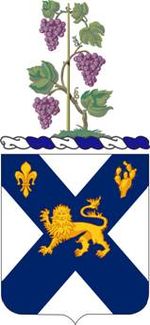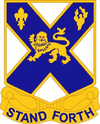102nd Infantry Regiment (United States)
The 102nd Infantry Regiment currently consists of one battalion in the Connecticut National Guard. Regimental designation is used only in historical tradition. It is one of several National Guard units with colonial roots. There is no regimental commander, staff or headquarters. The 1st Battalion, 102nd Regiment is headquartered in New Haven, Connecticut. Its mascot is Sergeant Stubby.
| 102nd Infantry Regiment | |
|---|---|
 | |
| Active | 1672–present |
| Country | United States |
| Branch | U.S. Army |
| Type | Infantry |
| Motto(s) | "Stand Forth" |
| Mascot(s) | Sergeant Stubby |
| Engagements | American Revolution American Civil War World War I World War II Operation Enduring Freedom |
| Insignia | |
| Distinctive unit insignia |  |
U.S. Infantry Regiments | |
|---|---|
| Previous | Next |
| 101st Infantry Regiment | 103rd Infantry Regiment |
Service history
World War I
In August 1917, the Regiment was organized with 3,755 Officers and enlisted men:
- Headquarters & Headquarters Company- 303
- Supply Company- 140
- Machine Gun Company- 178
- Medical & Chaplain Detachment- 56
- Infantry Battalion (x3)- 1,026
The 102nd was stationed at the Neufchateau, Vosges Training Area during the fall and winter of 1917[3] with the 26th Division also known as the Yankee Division which included the 101st, 103rd and 104th infantry regiments.
They were then deployed in March 1918 to the Chemin des Dames area where the men had their first experience with defensive and offensive operations and with poison gas.[4]
Next they were deployed in April 1918 to the Toul Sector in the American sector near the Beaumont Zone. They fought at Seicheprey.[5]
Next the 102nd was deployed in July 1918 to the Chateau Thierry area and were involved in the battles of the Champagne-Marne, Aisne-Marne and the Second Battle of the Marne (15 July – 6 August). They fought at Trugny, Épieds, and the La Fere Forest.[6]
Next the 102nd was deployed to Saint-Mihiel fighting at the Battle of Saint-Mihiel,[7] then the Troyon Sector[8] and finally at Verdun.[9]
After completing its war service in France with the 26th Division, the Regiment arrived at the port of Boston on 7 April 1919 on the U.S.S. Agamemnon and demobilized at Camp Devens, Massachusetts on 29 April 1919.
Between the Wars
Reconstituted in the National Guard in 1921 as the 170th Infantry, assigned to the 43d Infantry Division, and allotted to the state of Connecticut. Reorganized 20 October 1922 by withdrawal of the 2d Infantry Regiment, Connecticut National Guard, from the 169th Infantry Regiment (organized 23 May 1921 by consolidation and redesignation of the 1st and 2d Infantry Regiments as the Connecticut Regiment of Infantry; redesignated 169th Inf. on 7 October 1921) and redesignation of the 2d Infantry as the 170th Infantry. Regimental Headquarters organized 8 June 1923 and federally recognized at New Haven, Connecticut.
The 170th Infantry was redesignated as the 102d Infantry on 28 February 1924. The regiment, or elements thereof, were called up to perform the following state duties: riot control at the textile workers strike at Putnam, in September 1934; flood relief at Hartford from 19 March – 1 April 1936; hurricane relief in the vicinity of Rockville from 22–27 September 1938. The Regiment conducted annual summer training most years at Niantic between 1921–38. Inducted into active Federal service at New Haven on 24 February 1941 and moved to Camp Blanding, Florida, where it arrived 15 March 1941.[10]
World War II
When the United States reorganised their divisions from the four regiment square division to the three regiment triangular division. The 102nd was detached from the 43rd Division and sent to New Zealand in January 1942. The regiment garrisoned Christmas Island and Canton Island[11]
In July 1943, the Regiment was organized with 3,256 Officers and enlisted men:[12]
- Headquarters & Headquarters Company- 111
- Service Company- 114
- Anti-Tank Company- 165
- Cannon Company- 118
- Medical Detachment- 135
- Infantry Battalion (x3)- 871
- Headquarters & Headquarters Company- 126
- Rifle Company (x3)- 193
- Weapons Company- 156
Post War Service
The 1948 organization of the Regiment TOE 29-7T called for a strength of 3,774 Officers and enlisted men organized as below:
- Headquarters & Headquarters Company- 289
- Service Company- 186
- Tank Company- 148
- Heavy Mortar Company- 190
- Medical Company- 214
- Infantry Battalion (x3)
- Headquarters & Headquarters Company- 119
- Rifle Company (x3)- 211
- Weapons Company- 165[14]
Global War on Terrorism
In 2006, the 86th Infantry Brigade Combat Team (Mountain) was reorganized from a "heavy" brigade to a specialized light infantry formation. The 1–102nd Infantry was added as the brigade slowly formed from 2006, transitioning to the 42d Infantry Division.
The 86th IBCT mobilized in December 2009 at Camp Atterbury, Indiana and completed a Joint Readiness Training Center rotation at Fort Polk prior to deployment in support of Operation Enduring Freedom. The brigade returned home in December 2010 after being replaced by 2nd IBCT, 34th ID.
Current Assignment
As part of the 2020 Army Force Structure Realignment, the 86th IBCT – which includes the 1-102d IN – was moved in 2016 from the 42d ID to the 10th Mountain division.[15]
Lineage
- Organized 26 June in the Connecticut Militia as Regiment of New Haven County[16]
- Reorganized as the 2nd Regimental Militia on 11 October 1739 from existing companies in the Connecticut Colony
- Reorganized in 1816 and again in 1847 without material change
- Organized as the 2nd Connecticut Volunteers on 7 May 1861 and mustered out on 7 August 1861
- Organized as the 20th Connecticut Volunteers on 8 September 1862 and mustered out 13 June 1865
- Reorganized as the 2nd Infantry in 1865
- Redesignated as the 102nd Infantry Regiment on 22 August 1917 and assigned to the 26th Infantry Division
- Redesignated as the 169th Infantry and assigned to the 43rd Division on 7 October 1921
- Reorganized as the 170th Infantry 20 October 1922
- Redesignated 102nd Infantry and assigned to the 43rd Division on 28 February 1924
- Relieved from the 43rd Infantry Division and consolidated with 963rd Field Artillery Battalion to form 102nd Infantry on 1 May 1959[16]
References
- Connecticut Adjutant General's Report – 1930
- Maneuver and Firepower p56
- Military Map of the United States in 1918
- Connecticut Fights by Strickland pub.1930 Ch.4 p69
- Connecticut Fights by Strickland pub.1930 Ch.5 p82
- Connecticut Fights by Strickland pub.1930 Ch.6 p116
- Connecticut Fights by Strickland pub.1930 Ch.7 p170
- Connecticut Fights by Strickland pub.1930 Ch.8 p215
- Connecticut Fights by Strickland pub.1930 Ch.9 p234
- Connecticut Fights by Strickland pub.1930 Ch.10 p258
- The US Army Order of Battle from 1919–1941 p406
- p.15 Zimmer, Joseph E. The History of the 43rd Infantry Division, 1941–1945 Merriam Press, 1 October 1998
- Maneuver and Firepower p183
- Stanton, Shelby L. (1984). World War II Order of Battle. New York, New York: Galahad Books.
- Maneuver and Firepower p220
- https://ct.ng.mil/PressReleases/102nd_Repatch_Press_Release.pdf CONNECTICUT ARMY NATIONAL GUARD INFANTRY BATTALION RE-PATCHES AS ASSOCIATED UNITS PROGRAM GETS UNDERWAY 17 October 2016
- Sawicki, James A. (1981). Infantry Regiments of the US Army. Wyvern Publications. pp. 195–96. ISBN 978-0-9602404-3-2.